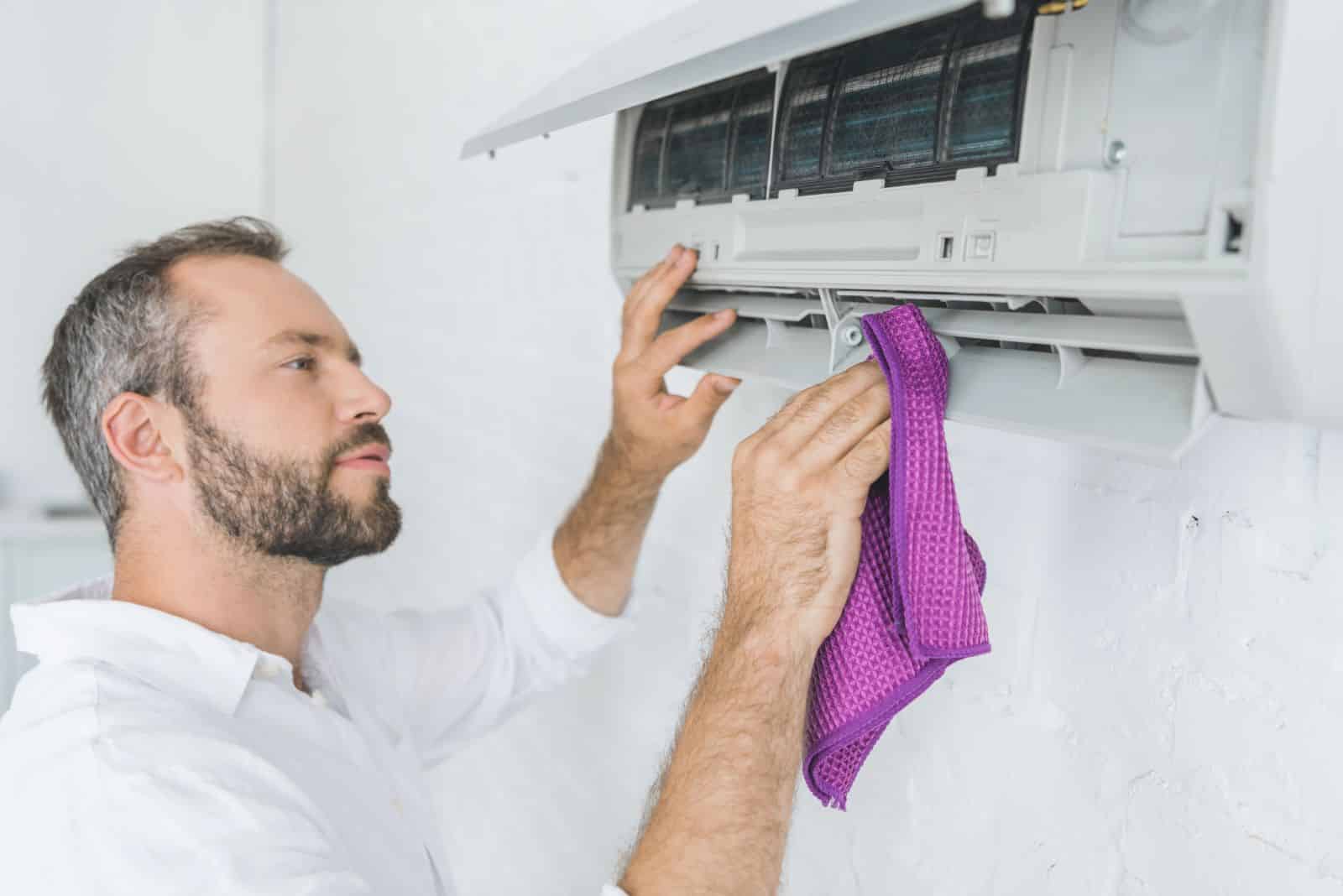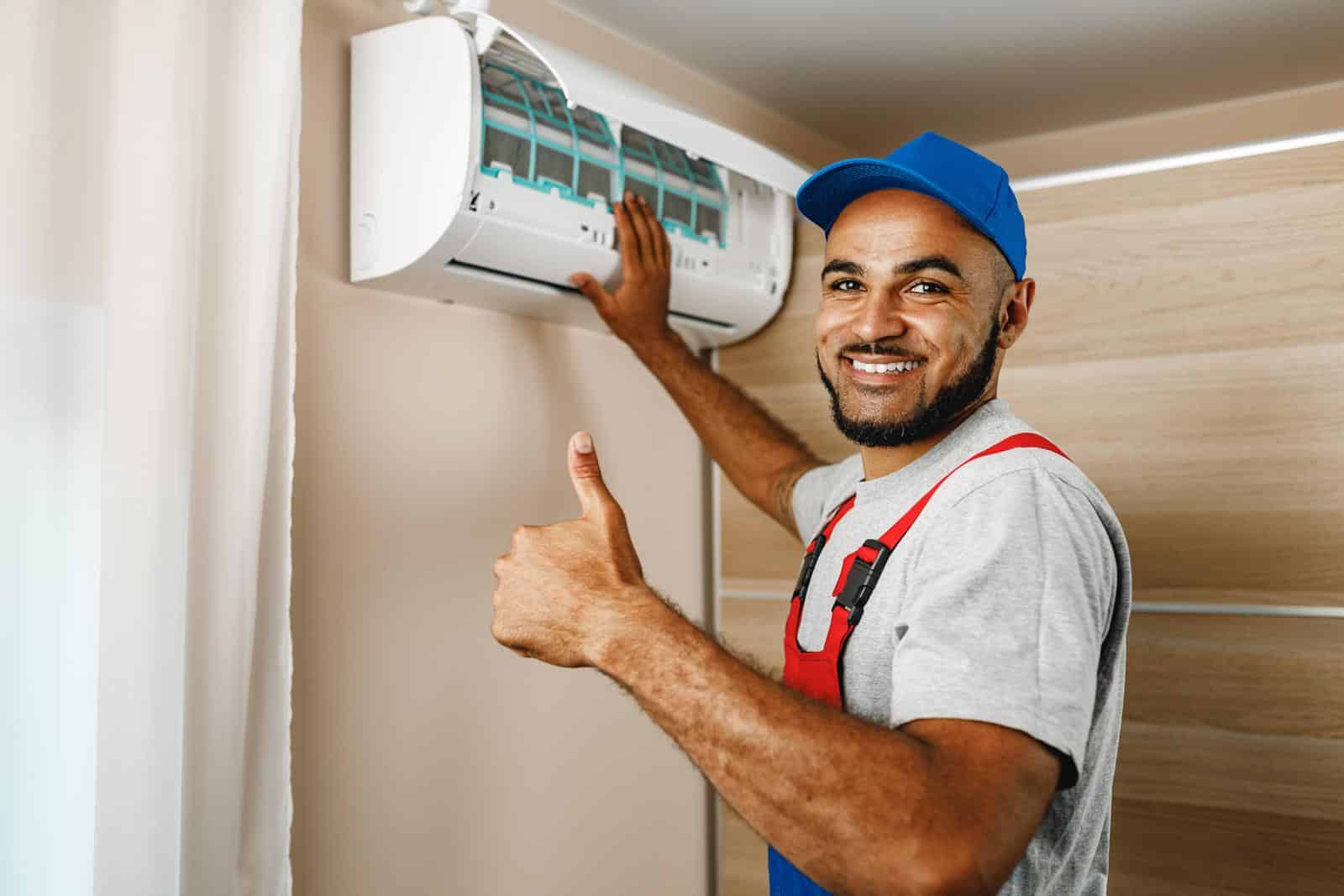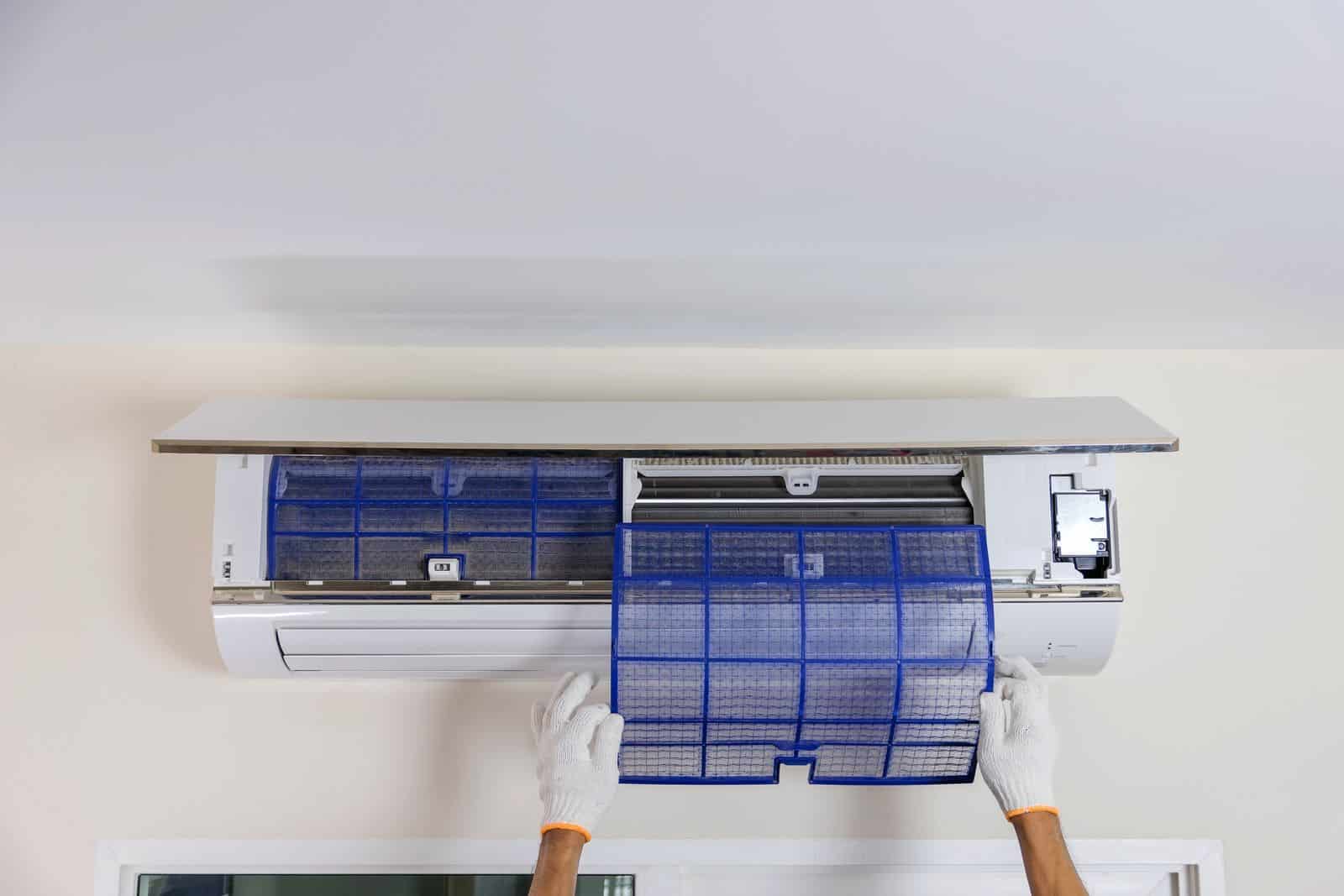Regular maintenance of your heating, ventilation, and air conditioning (HVAC) system plays a crucial role in maintaining optimal indoor comfort and energy efficiency throughout your home. One of the most fundamental yet impactful maintenance tasks any homeowner can perform is replacing or cleaning their air filter.
This simple procedure not only enhances indoor air quality by trapping dust, pollen, pet dander, and other airborne contaminants but also ensures your HVAC system, whether its a ducted or split system, operates at peak performance levels, ultimately reducing energy consumption and prolonging equipment lifespan.
Key Points
- Regular filter changes improve air quality and system efficiency – Clean filters reduce energy bills and extend HVAC equipment lifespan
- Most filters need replacement every 60-90 days – Homes with pets or allergies may require monthly changes
- Always turn off your HVAC system before starting – This ensures safety and prevents debris from entering the system
- Check filter direction arrows during installation – Incorrect orientation reduces effectiveness and may damage the filter
- MERV 8-11 filters suit most homes – Higher ratings provide better filtration but may restrict airflow in some systems
- Multiple purchase options available – Hardware stores, online retailers, and HVAC suppliers all stock replacement filters
- Washable filters require monthly cleaning – Allow complete drying before reinstallation to prevent mold growth
- Professional help may be needed – Persistent air quality issues or system problems warrant expert diagnosis

Why Is A Clean Filter Important?
A clean air filter allows unrestricted airflow through your system, reducing strain on the blower motor and other components. When filters become clogged with debris, your system must work harder to circulate air, leading to increased energy bills and potential premature equipment failure.
Additionally, dirty filters can cause poor air circulation and uneven temperatures throughout your home and may even contribute to frozen evaporator coils in the summer or overheating issues in the winter.
Step-by-Step Air Filter Replacement Process
Determining Your Filter’s Location
The positioning of your air filter varies significantly depending on your HVAC system configuration and home design. In most residential installations, you’ll find the filter in one of several common locations.
Check the return air grille, which is typically the largest vent in your home and is often located on a wall or ceiling in a central area like a hallway or living room. The filter may be housed directly behind this grille in a slot or compartment.
Alternatively, your filter might be situated near the indoor air handler unit, usually found in basements, utility rooms, attics, or closets. Look for a panel or access door near the blower compartment. In furnace systems, the filter is commonly located in the blower compartment itself or in the return air duct leading to the furnace.
Some newer homes feature whole-house air filtration systems with larger filters housed in dedicated cabinets connected to the main ductwork.
Understanding Air Filter Varieties
Modern residential HVAC systems utilise several distinct types of air filters, each with specific characteristics, maintenance requirements, and performance capabilities. Disposable pleated filters represent the most popular choice among homeowners due to their excellent particle capture efficiency and convenience.
These filters feature accordion-style pleated media that increases surface area for enhanced filtration performance. They’re manufactured with synthetic materials or cotton-polyester blends and are designed for single-use applications.
Washable panel filters, constructed from durable materials like aluminium mesh or synthetic foam, offer an environmentally conscious alternative that can be cleaned and reused multiple times over several years.
While initially more expensive, they provide long-term cost savings and reduce waste. However, they typically offer lower filtration efficiency compared to high-quality disposable filters.
Electronic air cleaners, also known as electrostatic precipitators, use an electrical charge to attract and capture particles. These sophisticated systems require periodic cleaning of the collection plates and occasional replacement of the electronic components. They excel at capturing very small particles but require more maintenance and higher initial investment.
High-efficiency particulate air (HEPA) filters provide the highest level of filtration, capturing 99.97% of particles 0.3 microns or larger. However, they may not be compatible with all residential HVAC systems due to their higher resistance to airflow, potentially requiring system modifications.
System Shutdown Procedures
Before beginning any filter maintenance, ensuring complete system shutdown is essential for both safety and preventing debris from being drawn into the system during the replacement process.
Locate your thermostat and switch it to the “off” position, waiting a few minutes for all system components to completely stop operating. You should no longer hear the blower motor running or feel any air movement from the vents.
For additional safety, especially when working on older systems or if you’re uncertain about electrical components, consider switching off the dedicated circuit breaker for your HVAC system at your home’s electrical panel.
This provides complete electrical isolation and eliminates any possibility of the system starting unexpectedly during maintenance.
Proper Filter Removal Techniques
Once you’ve located your filter and confirmed system shutdown, carefully remove the existing filter from its housing. Take note of the airflow direction arrows printed on the filter frame, as proper installation of the replacement filter requires matching this orientation.
Many filters have arrows indicating airflow direction, which should point toward the blower motor or away from the return air duct.
Disposable filters should be handled carefully to avoid shaking loose accumulated debris back into your living space. Place the used filter immediately into a large garbage bag to contain dust and allergens, then seal the bag before disposal. This prevents contaminated particles from redistributing throughout your home during the disposal process.
For washable filters, remove them gently and take them to an appropriate cleaning area, preferably outdoors or in a utility sink. These filters can often be quite dirty, so handling them carefully prevents spreading debris throughout your home.
Installing Your Replacement Filter
When installing a new disposable filter, verify that you’ve purchased the correct size by checking the dimensions printed on both the old filter and the new one. Common residential sizes include 16x20x1, 20x25x1, and 16x25x1 inches, though many other sizes exist.
The filter should fit snugly in its housing without gaps around the edges that could allow unfiltered air to bypass the filter media.
Pay careful attention to the airflow direction arrows on the new filter, ensuring they match the orientation of the previous filter. Installing a filter backwards significantly reduces its effectiveness and may damage the filter media. The arrows should point toward the blower motor or in the direction of airflow through the system.
For washable filters, ensure they’re completely dry before reinstallation. Installing a damp filter can promote mould growth and reduce filtration efficiency. After washing, allow the filter to air dry completely in a clean environment, which may take several hours or overnight, depending on humidity conditions.
System Restart and Verification
After successfully installing your new or cleaned filter, replace any access panels or grilles that were removed during the process. Return to your thermostat and switch the system back to your desired operating mode, whether heating, cooling, or auto. Listen for normal system startup sounds and verify that air is flowing properly from your supply vents.
Take this opportunity to check that the system is operating smoothly without unusual noises, vibrations, or airflow restrictions. If you notice any irregularities, double-check that the filter is properly installed and that all access panels are securely closed.

Filter Procurement and Selection
Where to Purchase Replacement Filters
Replacement air filters are widely available through numerous retail channels, each offering different advantages in terms of selection, pricing, and convenience. Local hardware stores and home improvement centres typically stock common filter sizes and types.
Allowing you to physically examine products and receive immediate assistance from knowledgeable staff. These retailers often carry major brands and can special-order uncommon sizes.
Online retailers provide the broadest selection and often offer competitive pricing, especially for bulk purchases or subscription services that automatically deliver filters at predetermined intervals. This approach ensures you never forget to replace your filter and often provides cost savings through volume discounts.
Specialty HVAC supply stores cater to professionals but welcome homeowners seeking high-quality filters or expert advice. These establishments often stock premium filter options not commonly found in general retail stores and can provide technical guidance for specific applications.
Many HVAC service companies also sell filters to their customers, often providing the convenience of professional installation and system inspection during routine maintenance visits.
Selecting the Appropriate Filter Specifications
Choosing the correct filter involves more than simply matching dimensions. Consider the MERV (Minimum Efficiency Reporting Value) rating, which indicates the filter’s ability to capture particles of various sizes. MERV ratings range from 1 to 16 for residential applications, with higher numbers indicating better filtration efficiency.
For most homes, MERV 8-11 filters provide an excellent balance of filtration performance and airflow characteristics. MERV 1-4 filters offer basic protection but limited particle capture, while MERV 13-16 filters provide superior filtration but may restrict airflow in systems not designed for high-efficiency filters.
Consider your household’s specific needs when selecting filter efficiency. Homes with pets, family members with allergies or respiratory conditions, or located in dusty environments may benefit from higher-efficiency filters. Conversely, basic filtration may be adequate for homes without these concerns.
Maintenance Scheduling and Best Practices
Optimal Replacement Frequency Guidelines
Filter replacement frequency depends on multiple factors, including filter type, household conditions, and system usage patterns. Standard disposable pleated filters typically require replacement every 60-90 days under normal conditions. However, homes with pets may need monthly replacements due to increased hair and dander accumulation. Similarly, households with family members suffering from allergies or asthma may benefit from more frequent filter changes to maintain optimal air quality.
During peak usage seasons, when your HVAC system operates continuously, filters accumulate debris more rapidly and may require more frequent attention. Spring and fall, when outdoor allergen levels peak, also warrant closer monitoring of filter condition.
Washable filters require monthly cleaning to maintain efficiency, with complete replacement every 6-12 months, depending on usage and cleaning frequency. Electronic air cleaners need monthly cleaning of collection plates and periodic replacement of electronic components according to the manufacturer’s specifications.
Environmental Factors Affecting Filter Performance
Several environmental conditions significantly impact filter lifespan and effectiveness. Homes located near construction sites, busy roads, or in areas with high pollen counts will experience faster filter loading and require more frequent replacements. Similarly, homes with multiple pets, especially those that shed heavily, will need more frequent filter maintenance.
Indoor factors also play a role in filter performance. Homes with poor sealing may draw more outdoor contaminants through the HVAC system, while those with indoor air quality issues, such as cooking odours, smoking, or high dust levels, will place additional demands on filtration systems.
Seasonal variations affect filter performance as well. Spring cleaning activities, increased outdoor activities that bring in more contaminants, and seasonal allergen spikes all contribute to faster filter loading during certain times of the year.

Professional HVAC Services and System Optimisation
Recognising When Professional Assistance Is Needed
While filter replacement is typically a straightforward homeowner task, certain situations warrant professional intervention. If you’re experiencing persistent air quality issues despite regular filter changes, unusual system noises, inconsistent temperatures throughout your home, or dramatically increased energy bills, these symptoms may indicate underlying system problems that require professional diagnosis and repair.
Additionally, if your system uses specialised filters, requires filter modifications, or if you’re uncomfortable performing maintenance tasks, professional service ensures proper installation and system optimisation. HVAC technicians can also inspect your entire system during filter replacement, identifying potential issues before they become costly repairs.
Comprehensive System Maintenance Benefits
Professional HVAC maintenance extends far beyond simple filter replacement, encompassing complete system inspection, cleaning, and optimisation. Technicians can clean evaporator and condenser coils, check refrigerant levels, inspect ductwork for leaks, calibrate thermostats, and verify proper system operation.
Regular professional maintenance typically includes safety inspections of gas connections, electrical components, and combustion systems, ensuring your family’s safety while maximising system efficiency and longevity. Many HVAC companies offer maintenance agreements that provide scheduled service visits, priority scheduling for repairs, and discounts on parts and labour.
This comprehensive approach to system maintenance, combined with regular filter replacement, ensures optimal comfort, efficiency, and air quality while protecting your investment in home comfort equipment.
